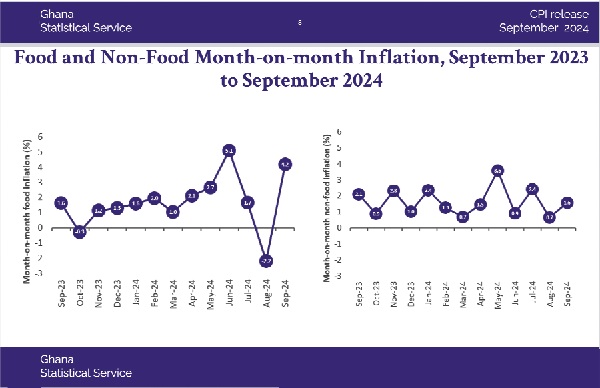
Food inflation threatens end year target — Govt Statistician wants seasonality issues addressed
Food inflation continues to threaten the government’s end-year inflation target of between 15% and 17%.
Ghana’s inflation increased for the first time in six months, with the rate increasing from 20.4% in August to 21.5% in September.
This was largely driven by food inflation which rose by three percentage points from 19.1% to 22.1%.
The surge in food costs was attributed to price hikes in staple items such as cereals, vegetables and other essential food products.
Growing fears
There are growing fears among players in the agricultural space that, the situation may not be different but rather get worse in the coming months, a development which is likely to affect the government’s annual inflation rate target.
Govt statistician concerned
“It is a call for concern. From a seasonality point of view we see the influence of bumper harvest in the month of August and September, but we need to keep in mind that it peaked in August and slowed in September onwards.
“Its ability to contain the market in September depends on our ability to have stored enough and the extent to which we got significant harvest during the rainy season,” Government Statistician, Professor Samuel Kobina Annim said.
He said: “We hope that going forward, we can address these seasonalities as it is one of the topical issues in the Planting for Food and Jobs (PFJ) Phase II document to ensure that as a country, seasonalities does not influence the production of our agriculture products.”
Non-food inflation
Non-food inflation on the other hand remained relatively stable.
The year-on-year non-food inflation rate dropped from 21.5% in August to 20.9% in September; Inflation for locally produced items 23.4%, compared to 17% for imprinted items.
Regional updates
On the regional level, inflation rates across Ghana's 16 regions showed significant variation in September.
The Savannah Region recorded the highest inflation rate at 36.4%, reflecting the acute impact of rising food prices in that area, with food inflation reaching 49.9%.
In contrast, the North East Region had the lowest inflation rate of 16.7%, with food inflation at 15.1%.
Consistency
Ghana has been battling high inflation since 2022, with the rate peaking at 54.1% in December 2022.
This year, the country has witnessed a consistent decline in inflation which has prompted the Monetary Policy Committee (MPC) of the Bank of Ghana to cut the policy rate twice this year.
The committee first cut the rate by 100 basis points from 30% to 29 per cent and recently cut the rate again by 200 basis points to 27% .